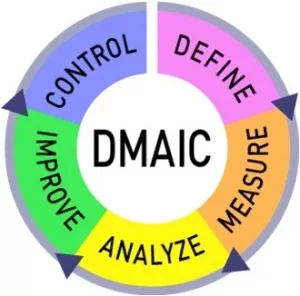Six Sigma (6σ) methodology uses statistical analysis and improvement tools to minimize process variation. The concept was introduced by Motorola Engineer Bill Smith in 1986 and became popular when General Electric CEO Jack Welch made it core to the GE strategy in 1995 and announced $350 Million in savings from 6σ projects. Many of the largest US companies began Six Sigma initiatives that decade, but Six Sigma Methodology has since gotten a bad rap.
What is Six Sigma?
Statisticians use the Greek letter σ (sigma) as a variable representing variation. Outcomes of a process, selection, etc. are distributed according to statistical models, with the most common being the standard normal distribution. This bell curve, shown below, has most outcomes at the average of the distribution, with less-likely occurrences the further you get from the midpoint. Sigma represents how tightly the outcomes are grouped around the average.

If the outcomes of the process being studied fall within specification to within plus-or-minus three sigma the outcome will pass 99.73% of the time. While this would be acceptable for many processes in home construction, customer service, etc. levels of plus-or-minus six sigma (or better!) are desirable in other industries. Look at the differences below:

Six Sigma Methodology
Six Sigma methodology and tools are designed to improve your processes so they better achieve the desired outcome (on average) and also have a variation such that the outcomes you produce have less than 3.4 defective outcomes per million. This results in 6σ performance.
The steps in Six Sigma process improvement are DMAIC, a simple five-phase project methodology inspired by the Plan–Do–Study–Act Cycle.
DMAIC
The five phases of DMAIC are:

- Define the system, customer requirements, and project goals.
- Measure the current process.
- Analyze the process data to understand relationships and factors leading to the root cause of the defect(s).
- Improve the process by correcting root cause issues and establish the process capability.
- Control the improved process to ensure deviations are corrected before they result in defects.
DMAIC process improvement projects are led by Six Sigma “Black Belts” who have been trained in DMAIC phases and statistical methods of process data analysis.
Why Six Sigma Methodology has a Bad Rap
Despite the notable success of Six Sigma programs at Motorola, General Electric, and several other large companies, Six Sigma methodology is no longer a focus for most companies. I became a Six Sigma Green Belt and then Black Belt nearly twenty years ago and can share my thoughts on why six sigma methodology has a bad rap.
- Six Sigma analysis is complex and expert-driven. While Lean principles include respect for people and encourage continuous improvement from front-line workers, Six Sigma data analysis is complex. Black Belts lead experiments to reduce variations that are not necessarily understood or embraced by employees. This is one reason why the Wall Street Journal reported that more than 60% of projects fail.
- Six Sigma project savings are often theoretical and never occur. Another issue I experienced first-hand is projects with expected savings not being fully implemented. I worked with a team that claimed to have saved millions of dollars through Six Sigma projects. When we looked back, however, we found that most of the savings never materialized. For example, a project that saved the cost of 2.4 FTEs (full-time equivalent employees) resulted in zero savings when the employees were not actually laid off.
- Process data is often flawed or wrong. Six sigma data analysis requires good data, which I have found is often lacking for the process(es) being improved. It is better to use Lean methodologies to understand and standardize the process first.
- Six Sigma statistics may ignore other root causes. Relying on statistical analysis can lead Black Belts to miss some human factors and special cause issues. DMAIC thinking works well with computers and machines, but humans will always resist being “controlled.”
- Six Sigma levels are not enough! In 2023, 6σ levels of quality are inadequate for many processes and industries. Semiconductors, for example, require millions of etched circuits on a single chip and just one issue makes the chip defective. And none of us would want to have only a 6σ level of success for air travel – there would be an airplane crash every 4-5 days!

Lean Six Sigma
At Lean East, we continue to teach some Six Sigma tools and methods in combination with Lean thinking. Lean approaches and principles are enhanced when coupled with Six Sigma data analysis tools that help understand process variation.
Six Sigma methodology works, but only when used appropriately. Like any other tool in your toolbox, you shouldn’t use a hammer to tighten a screw. Success comes from knowing which tool should be used in a particular situation, and also which tools are not appropriate.
We will cover some other process improvement tools and methods in a future post.


Related Posts
The God Complex: Why We’re All Making This One Mistake
How I am Changing the Career Advice I Give My Kids
This is Never Going to Work: Getting Lean Projects Unstuck